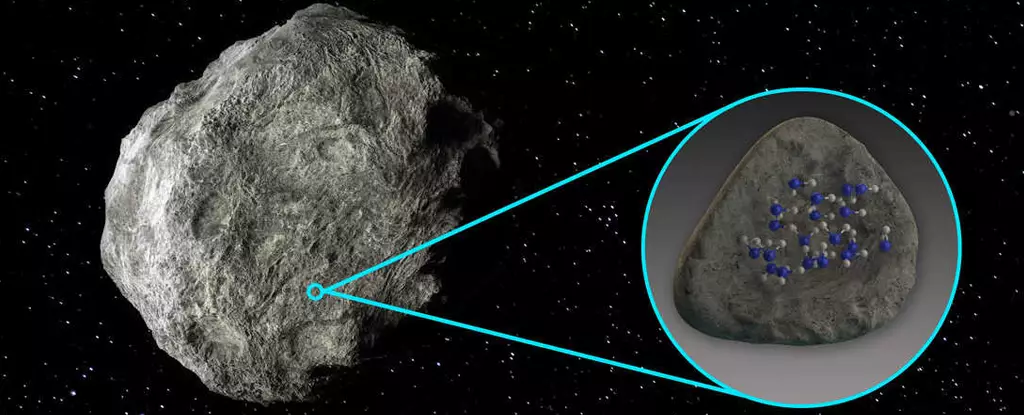The vast expanse of our Solar System is home to various celestial objects, ranging from planets and moons to comets and asteroids. In particular, asteroids have captured the attention of scientists due to their potential wealth of information about the early formation of our Solar System. Until recently, it was widely believed that any water present on asteroids had long evaporated. However, a groundbreaking study utilizing data from the SOFIA infrared telescope has revealed the unexpected existence of water on the asteroids Iris and Massalia. This discovery poses intriguing questions about the composition and distribution of water not only within our Solar System but also in exoplanetary systems and the potential for extraterrestrial life.
Among the vast collection of asteroids, Iris stands out with a diameter of 199 km (124 miles), making it larger than approximately 99 percent of other known asteroids. Located within the asteroid belt between Mars and Jupiter, Iris completes one orbit around the Sun every 3.7 years, at an average distance of 2.39 astronomical units. Massalia, with a diameter of 135 km, is comparable in size to Iris and shares a similar orbit. The presence of water on these sizable asteroids challenges the previous notion that water should have evaporated from their surfaces long ago.
One of the key factors influencing the composition of asteroids is their distance from the Sun. Closer to the Sun, silicate asteroids devoid of ice dominate, while further out, icy asteroids become more common. By exploring the distribution of asteroids and their composition, scientists can gain valuable insights into the formation of planets and asteroids, as well as the distribution of elements in the early solar nebula. Moreover, understanding the distribution of water within our own Solar System holds significance for studying exoplanetary systems and the likelihood of finding extraterrestrial life.
The recent discovery of water on the asteroids Iris and Massalia was made possible through the use of data captured by the Stratospheric Observatory for Infrared Astronomy (SOFIA). SOFIA retired in 2022 after providing invaluable insights into various astronomical phenomena. Interestingly, this is not the first time that SOFIA has contributed to water-related discoveries. In October 2020, SOFIA identified water on the Moon, utilizing its Faint Object InfraRed Camera (FORCAST) to detect the spectral signature of water molecules on the lunar surface. The study estimates the presence of approximately 350 milliliters of water in a cubic meter of lunar soil, consistent with the findings on Iris and Massalia.
The lead author of the study, Dr. Anicia Arredondo from the Southwest Research Institute, confirmed that the volume and prevalence of water on the asteroids align with those found on the Moon. On these celestial bodies, water is locked up within minerals and absorbed by silicates. Additionally, data from two fainter asteroids, Parthenope and Melpomene, was analyzed, although inconclusive due to excessive noise. The limitations of the FORCAST instrument in detecting the spectral feature of water on these asteroids call for further analysis.
The discovery of water on asteroids Iris and Massalia opens up new avenues for understanding the distribution and origin of water in the Solar System. Further research is required to fully comprehend the dynamics of water across various celestial bodies. To aid in this endeavor, the team behind the study intends to utilize the James Webb Space Telescope, renowned for its high-quality optics and superior signal-to-noise ratio. This advanced telescope is expected to provide deeper insights into the presence and characteristics of water on asteroids, enhancing our understanding of the Solar System’s history.
The implications of this discovery extend beyond our Solar System. By studying the composition and distribution of water in other planetary systems, scientists can gain valuable insights into the potential habitability of exoplanets and the existence of extraterrestrial life. Undoubtedly, the exploration of water on asteroids paves the way for future discoveries and raises captivating questions about the nature of our cosmic neighborhood.
The recent revelation of water on asteroids Iris and Massalia challenges previous assumptions and sheds light on the complexities of our Solar System. Through the use of advanced telescopes like SOFIA and future missions with the James Webb Space Telescope, scientists are poised to unlock further secrets about the composition, distribution, and origins of water in our celestial surroundings. As our understanding of the Solar System expands, so too does our knowledge of exoplanetary systems and the potential for life beyond Earth. The journey to unravel the mysteries of water in our Solar System has only just begun, and every discovery brings us one step closer to unraveling the enigma of our cosmic existence.


Leave a Reply